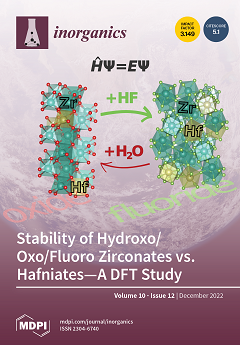The rigid-backbone bidentate ligands Indoline-2-carboxylic acid (IndoliH) and Indole-2-carboxylic acid (IndolH) were evaluated for rhodium(I). IndoliH formed [Rh(Indoli)(CO)(PPh
3)] (
A2), while IndolH yielded the novel dinuclear [Rh
1(Indol’)(CO)(PPh
3)Rh
2(CO)(PPh
3)
2] (
B2) complex (Indol’ = Indol
2−), which were characterized by SCXRD. In
B2, the Rh
1(I) fragment [Rh
1(Indol’)(CO)(PPh
3)] (bidentate
N,O-Indol) exhibits a square-planar geometry, while Rh
2(I) shows a ‘Vaska’-type trans-[O-Rh
2(PPh
3)
2(CO)] configuration (bridging the carboxylate ‘oxo’ O atom of Indol
2−). The oxidative addition of MeI to
A2 and
B2 via time-resolved FT-IR, NMR, and UV/Vis analyses indicated only Rh(III)-
alkyl species (
A3/
B3) as products (no migratory insertion). Variable temperature kinetics confirmed an associative mechanism for
A2 via an equilibrium-based pathway (Δ
H≠ = (21 ± 1) kJ mol
−1; Δ
S≠ = (−209 ± 4) J K
−1mol
−1), with a smaller contribution from a reverse reductive elimination/solvent pathway. The dinuclear complex
B2 showed the oxidative addition of MeI
only at Rh
1(I), which formed a Rh(III)-alkyl, but cleaved the bridged Rh
2(I) site, yielding trans-[Rh
I(PPh
3)
2(I)(CO)] (
5B) as a secondary product. A significantly smaller negative activation entropy [Δ
H≠ = (73.0 ± 1.2) kJ mol
−1; Δ
S≠ = (−21 ± 4) J K
−1mol
−1] via a more complex/potential interchange mechanism (the contribution of Δ
S≠ to the Gibbs free energy of activation, Δ
G≠, only ±10%) was inferred, contrary to the entropy-driven oxidative addition of MeI to
A2 (the contribution of Δ
S≠ to Δ
G≠ ± 75%).
Full article





